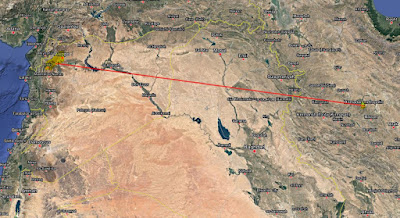On August 15, the Russian Air Force deployed five of its Tu-22M3 (NATO: Backfire C) strategic bombers--including aircraft RF-34038 shown in the image--from home bases in Russia to Hamedan Air Base, Iran.
The Russians claim that the bombers are deployed to Iran to conduct airstrikes against targets of the Islamic State in Iraq and Syria (ISIS) located in Syria. Although this matches the Russian narrative since they began military operations in Syria last September, the overwhelming majority of their targets have been anti-regime rebels, including groups supported by the United States.
The day after they arrived in Iran, the bombers, accompanied by Su-34 (NATO: Fullback) tactical fighter-bombers, struck targets in Aleppo, Idlib and Dayr al-Zawr provinces. While the targets in Dayr al-Zawr are almost certainly ISIS, the targets in Aleppo may or may not be--there are elements of Islamist groups there which are also valid targets--the targets hit in Idlib province are highly unlikely to be ISIS or other terrorist groups.
Idlib has come under intense Russian bombing over the past two weeks in retaliation for the rebel downing of a Russian helicopter near the city of Saraqib, about 25 miles southwest of Aleppo. After the helicopter was downed, the corpses of the five-man crew were abused and dragged behind trucks. Saraqib has been hit hard almost daily, as has the provincial capital of Idlib city.
The timing of the deployment and the willingness of the Iranians to grant the Russians use of their base and airspace indicates just how critical the military situation is in Syria in general, and in Aleppo in particular. Iran has not granted foreign use of its air bases since the creation of the Islamic Republic in 1979.
It was only a short time ago that the Syrian Army, backed by its Iranian, Hizballah, Iraqi Shi'a militia and even Afghan Shi'a volunteers, was able to surround and besiege Aleppo. The key to that successful operation was the massive amount of Russian air power committed to the effort.
That success was short-lived. The rebels mounted a surprisingly effective campaign to break the siege, and were successful. Despite continued waves of Russian airstrikes throughout the city, the rebels were able to punch through the Syrian (and their allies) lines.
Especially troubling was what appeared to be the deliberate targeting of hospitals and medical facilities in Aleppo and other cities across northern Syria by the Russian Air Force. (See my article, Russian Air Force targeting hospitals - war crimes, Mr. Kerry?) That campaign against medical facilities continues.
This bomber deployment to Hamedan is a smart move on the part of the Russians. It allows the Russians to provide better air support to the Syrian forces in Aleppo--a critical interest for the Iranians who are losing men in the fighting there every day. This was probably the "sales pitch" made by the Russians for access to the air base.
In the past, the Russians have launched long-range bombers from air bases in southern Russia to strike targets in Syria. The flight time to target was well in excess of two hours. Operating from Hamedan, that flight time is decreased in some cases to less than one hour, depending on target location.
It is more than just time and distance to a target. Normally, the limiting factor in air operations is the takeoff weight of the aircraft. Planners must decide how much fuel and munitions are to be carried for each mission. In the absence of aerial refueling operations--these bombers are not refuelable--the distance to the target determines how much fuel must be carried.
The further the target from base, the more fuel is required. More fuel necessarily means less munitions. It is always a trade off--you may be able to fly a long way to strike a target, but will you have enough firepower to make a difference once you get there?
Now that the Russians are operating in much closer proximity to their target area, they are able to carry less fuel to strike their targets, allowing greater weapons loads. It makes sense.
Compare this to the U.S. Air Force operating fighters and drones from Incirlik Air Base, Turkey, rather than flying much longer distances from bases in Persian Gulf Arab countries. While operating from foreign air bases is quite normal for American forces, Russian forces have not done it since the collapse of the Soviet Union - now they have air base access in two Middle East countries.
I think it interesting to note that in addition to clearance to operate from an Iranian air base and use Iranian airspace, Russia also received clearance to traverse Iraqi airspace to conduct air strikes in Syria. Russian transport aircraft traverse Iranian and Iraqi airspace daily, and on several occasions, the Russians have fired cruise missiles that crossed the airspace of both countries.
Iraq's agreement is not a surprise. When it comes to fighting ISIS--and supporting the survival of the Bashar al-Asad regime in Damascus--the Iraqis are allied with the Syrian, the Russians, Iranians and Hizballah.
To the people in the region, it is the Americans that seem to be out of step. We work with the Iraqis and tolerate the Iranians while fighting ISIS in Iraq, but are on opposing sides in Syria. War does indeed make strange bedfellows.
The Russians have played their hand well. Russian Federation President Vladimir Putin saw a chance to move into a position of power and influence in Syria in 2015--and he took it. He saw another opportunity in Iran just this week, and again, he seized it. Gaining access to an Iranian air base? It is the smart thing to do.
Rather than falling into a quagmire in Syria as President Obama warned his Russian counterpart in 2015, Putin seems to be calling the shots in Syria.
Well played, Mr. Putin, well played.
Tweet




.jpg)
